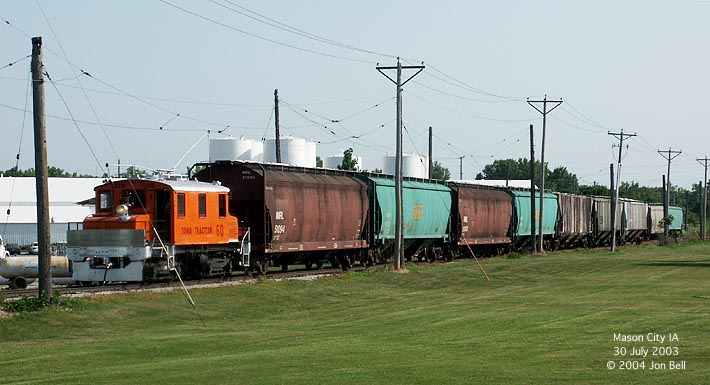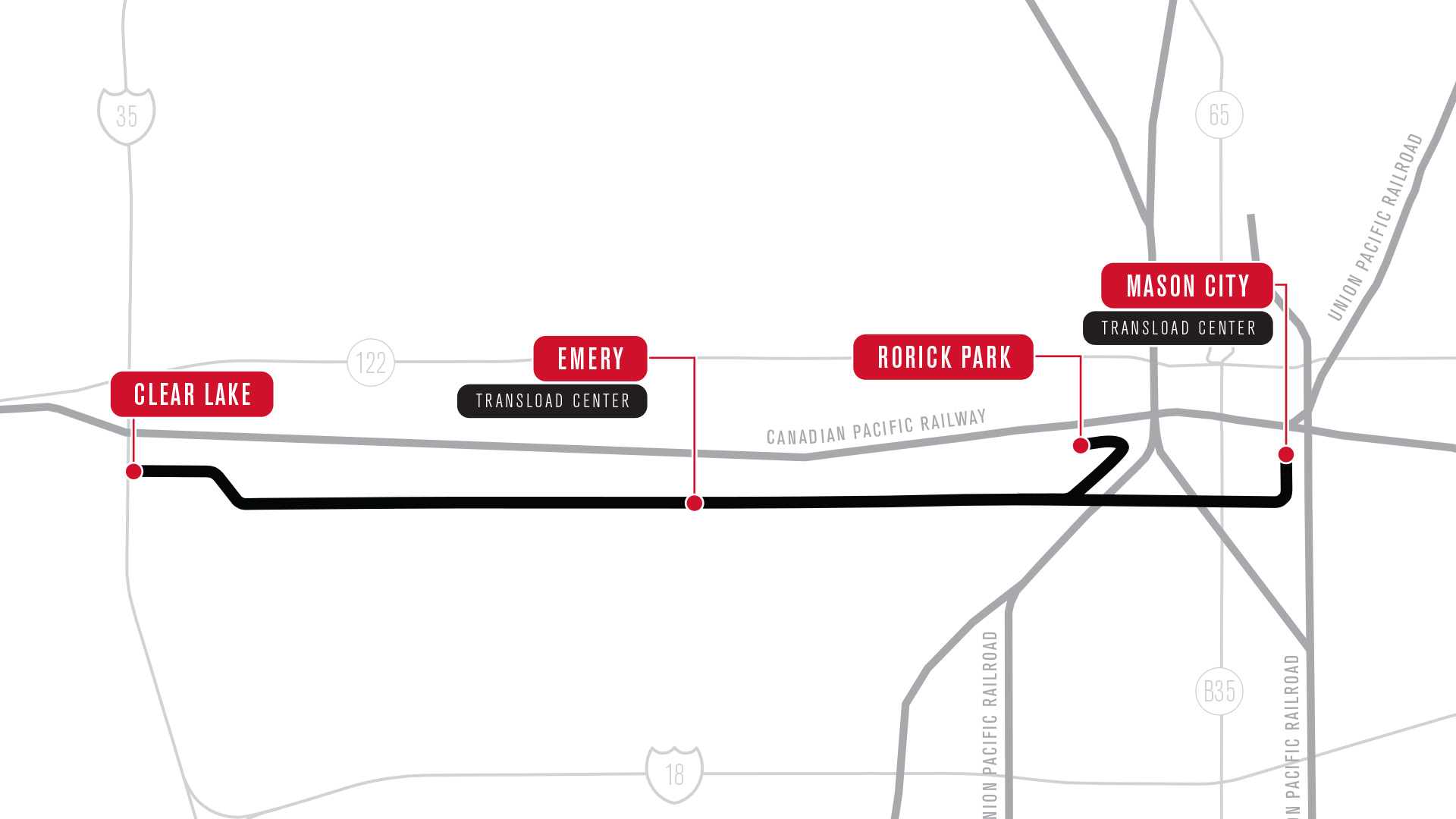We live in a time, right now, where anachronisms are not only appreciated but celebrated. Bars and restaurants will brag about how their food has given them almost or over one hundred years of service, old folks will roll around in their mid-century land yachts from an age where chrome was considered a safety feature, and of course there come the old railroads that still operate in somewhat original form like the South Shore Line or the Chicago Loop. Among the Midwestern railroads, there is one tiny little freight operation in the Hawkeye State of Iowa that has continued to tootle along, as if nothing's happened to it in the 100+ years its been in operation. Today, we know this little line as the Iowa Traction Railway (IATR), but its history goes back farther, all the way to 1897, and it is a line that deserves to be remembered and celebrated.
-----
The Mason City & Clear Lake Railway
 |
Bayside Amusement Park in its heyday. The park was almost destroyed in a tornado in 1931, then closed in 1958. (Clear Lake Iowa Alumni) |
Rail service on the Iowa Traction began on July 4, 1897, showing that some railroad history doesn't settle for simple Tuesday. Founded as just another interurban electric railroad by local utility magnate William E. Brice, the Mason City & Clear Lake Railway (MC&CL) was intended to be a pleasure-trip line 10.4 miles long between the city center at Mason and Clear Lake, through the town of Emery. To bring in more local residents and travelers from all corners of the Corn State, the proprietors at Clear Lake constructed the Bayside Amusement Park in 1909, with direct connection to the MC&CL. This theme park, like Clear Lake as well, only operated seasonally so when the line was winter-struck, the railway had to keep operating to keep its finances in the black. Luckily, they didn't have to think that hard to find a solid moneymaker.
 |
| A MC&CL baggage/express trailer from the Street Railway Review of 1891. At this time, the line was 17 miles in total with yard and main. (Carnegie Library of Pittsburgh) |
From the start, Clear Lake had a thriving ice delivery business. Its name, and its fresh water contents, made for high-quality refrigeration and due to its proximity to the railway, the MC&CL made a cool mint transporting ice to its main interchange at Mason City. Trains belonging to the Rock Island, Chicago & North Western, and the Milwaukee Road then took the ice all over the Eastern United States. This profitable service soon extended past wintertime, as the MC&CL moved into the freight business. It wasn't uncommon for an interurban passenger railroad to develop a freight service, especially out in the Midwest and in Iowa, but due to the niche service and small operation, the MC&CL was able to adapt as a carload freight business easily. In 1913, the railroad changed hands to the United Light & Railway Company of Iowa, with its subsidiary status enabling it to received subsidized electric power.
Freight Finds Its Niche
 |
| The Mason City Terminal on January, 1956. Snowsweeper No. 02 is on the left. (Photo Librarian) |
Usually on this blog, we'd lament the end of passenger service for any interurban railroad as the loss of passion and romanticism giving way to the dreariness of buses, but for some reason the MC&CL was different. Despite passenger numbers eroding starting in 1923 and new investment in lighter interurban cars, the MC&CL seemed to focus more and more on freight. Like a hobbyist obsessed with a new project, the interurban line shifted more of its focus on freight, even when passenger rail service officially ended on August 30, 1936. Rather than renew its charter to provide Mason City with passenger service, the railroad instead opted to use buses and had "no interest" in any kind of renewal.
Also interesting, the MC&CL was purchased in 1960 by General Motors executive, railroad enthusiast, and all-around rebel Harold C. Boyer. Instead of replacing the railroad with GM trucks, Boyer wanted to connect his new Iowa Terminal Railroad (ITRR) to his other interurban called the Charles City Western (CCW) in Charles City, IA, as well as out to the Rock Island at Marble Rock, IA. The CCW was a large, 23-mile interurban line that would be able to give the ITRR room to grow and be profitable, and the Rock Island connection would give more terminal possibilities but unfortunately the latter was not to be. After ground was broken at the end of 1963 (and the line between Emery and Clear Lake was closed), Boyer passed two years later in May 1965. The plans to connect to the Rock Island were soon scuttled and the "Mason City Division" of the ITRR continued to operated in truncated form through the 1960s.
Electric Power All the Way
 |
| MC&CL No. 4, quite possibly the only Pullman locomotive ever built. It's quite ornate and tiny and I want it. (Giovanni Fullin, Don Ross) |
Around this time, the Iowa Terminal also inherited new locomotives. Prior to the 1960s, the locomotives running the line were hilarious home brews and other interesting used locomotives form other railroads. One of the most unique pieces of equipment was dubbed "The Pig", but was built as MC&CL No. 4 by Pullman. Yes, Pullman built a tiny little electric locomotive. According to my research, it seems to have been the only one they built. Other locomotives came from other sources, like ex-New York & Brooklyn Bridge Railway Pullman trailer No. 97, which was purchased in 1909 and rebuilt as a freight motor. Another odd locomotive, No. 3, was purchased from the Iowa & Illinois Railroad in 1919, but it was originally built in 1904 and modified in 1912. After a fire destroyed its cab, the MC&CL rebuilt it as No. 51 with a much longer, many-windowed cab that just looked... interesting.
 |
| Mason City & Clear Lake No. 51 (originally No. 3), making one wonder how many windows do you really need on your locomotive? (Frank Hicks) |
 |
| Steeplecabs 54 (left) and 50 (right) pose for a picture at Mason City. Note No. 50's sophisticated anticlimbers. (Drew Jackisch) |
Disaster and Struggles
 |
| A fire at a SEPTA carhouse, used for dramatic purposes. (Temple University Digital Collections) |
Unfortunately, despite having both a big system combining the Charles City and Mason City divisions, and plenty of electric locomotives with spares upon spares, disaster stuck the Iowa Terminal. On Thanksgiving Day, 1967, the Emery carbarn and its contents were destroyed after a fire began in a nearby lumberyard. Locomotive No. 52 and Express Cars Nos. 31 and 34 were among the equipment lost, along with the primary rotary converter and much of the tools and spare parts. Despite this setback, electric service was resumed a week later as key parts of the system (and key equipment) still remained intact. In May, 1968, disaster struck again as a tornado ripped through Charles City and destroyed the CCW's overhead wires. Instead of repairing the wires, the owners instead transferred the CCW's remaining electric locomotives to the ITR and dieselized the line. (A diesel line had already been set up to serve the White Farm Equipment plant, which dissuaded electric power near its foundry. With renewed determination, a new carhouse and company headquarters was built in Emery, and the Charles City division was abandoned some years later.
The following years were not kind to the Iowa Terminal and its gallant electric engines. Their main interchange customers were consolidated into bigger railroads (Canadian Pacific, Union Pacific), truck traffic was on the rise, and the 1980 Farm Crisis killed local business after a sharp drop in commodity and land prices made the business unprofitable. Thankfully, the line was protected under the Staggers Rail Act of 1980 (which deregulated the railroads and allowed them to set their own rates and contracts) which helped them run as cheap as possible, with as small a crew as possible, to gain back a customer base. Between 1980 and 1982, the railroad invested in 75 freight cars for their customers as now that their old connecting railroads were gone, the new ones could not provide their own cars in a timely manner. By the time the railroad was purchased once more by Dave Johnson in 1987, the company was on strong footing once again.
A Modern-Day Interurban
 |
| Steeplecab No. 50 demonstrates its raw power on a long line of covered hoppers in Mason City, IA, July 30, 2003. (Jon Bell) |
 |
| Iowa Traction's current operating region. (Progressive Rail) |
 |
| Ex-North Shore 727 and Steeplecab no. 60 relive the olden days on the IATR, with 727 bound for Mason City, 2009. (Scott Marsh) |
Other IATR equipment are preserved all around the Buckeye state. St. Louis freight engine No. 53 (originally from the Texas Electric as an interurban car) is now preserved at the Boone & Scenic Valley in Boone, IA. North Shore Line No. 727, the line's only surviving interurban passenger car, was originally displayed at the Iowa Trolley Park in Clear Lake, but now operates as a charter car on the IATR mainline and lives with fellow ex-North Shore 234 (now IATR 34), an express car-turned-tool car, in the Mason City carbarn. Outside of the state, the Rockhill Trolley Museum in Pennsylvania owns snow sweeper No. 3, which also operates even when there is no snow at all. The fact that such a railroad can continue operating today is nothing short of a miracle, and it's hopeful in the hearts of all traction and railroad enthusiasts that the Iowa Traction keeps its poles held high and powers on in perpetuity.
| Two icons of railroading meet at Mason City, with 4014 on the former Rock Island line to Boone, July 16, 2019. No. 51 just turned shy of 100 years old. (Jim Wrinn) |
-----
Thank you for reading today's Trolley Tuesday post! As it's my birth month, I thought we'd cover a special little railway to celebrate before jumping into this month's topic of Pennsylvania trolleys. Call it "SEPTAmber" if you will. (Yes, feel free to call out my bad pun too!) If you want to learn more about the Iowa Traction, feel free to follow its website here. More information about IATR No. 53 can be found at the Boone & Scenic Valley Railroad's website here, and I just want to personally thank all the museums and railfans who read our articles and share them all across the internet. As always, you can follow myself or my editor on our Twitters, and maybe support us by buying a trolley shirt from my Redbubble store. Until Thursday, ride safe!

No comments:
Post a Comment